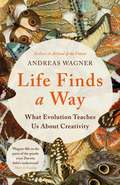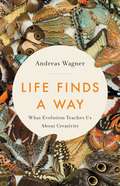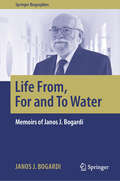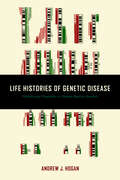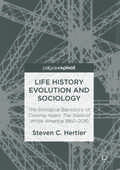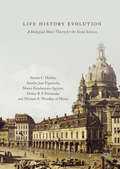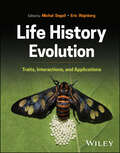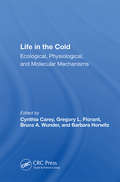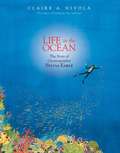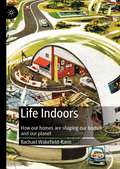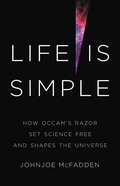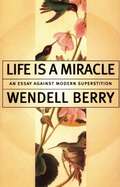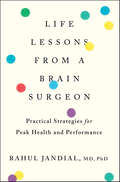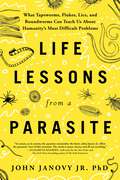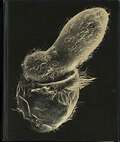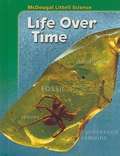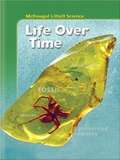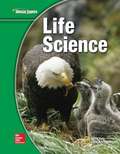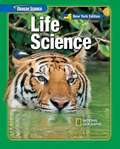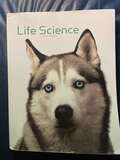- Table View
- List View
Life Everywhere
by David DarlingTo many people, the main question about extraterrestrial life is whether it exists. But to the scientific community, that question has already been answered: it does, and within our solar system. The new science of astrobiology is already being practiced at NASA's Astrobiology Institute and the University of Washington's new Department of Astrobiology. Life Everywhere is the first book to lay out what the new science of astrobiology is all about. It asks the fascinating questions researchers in astrobiology are asking themselves: What is life? How does it originate? How often does life survive once it arises? How does evolution work? And what determines whether complex or intelligent life will emerge from more primitive forms? Informed by interviews with most of the top people in this nascent field, this book introduces readers to one of the most important scientific developments of the next century.
Life Finds a Way: What Evolution Teaches Us About Creativity
by Andreas Wagner&‘This is a wonderful, mind-expanding book. Prepare to be surprised, enlightened and awed as Wagner reveals the sources of human and natural creativity.&’ – Alice RobertsIn Darwin&’s survival of the fittest, each step must be uphill as life progresses towards an evolutionary peak. There is no turning back. So what happens when life needs to cross a valley in the wilds of an adaptive landscape to reach the highest summit? World-renowned biologist Andreas Wagner reveals that life does not only walk – it also leaps. Drawing on pioneering research, Wagner explores life&’s creative process and how it bears a striking resemblance to how we humans work. A beguiling symmetry links Picasso struggling through forty versions of Guernica and the way evolution transformed a dinosaur&’s claw into a condor&’s wing. This new understanding is already revolutionising our approach to problem-solving across the sciences. In the near future, applied in spheres as diverse as the economy and education, it will enable us to do so much more. Life Finds a Way is a thought-provoking and deeply hopeful look at the force that shapes our world.
Life Finds a Way: What Evolution Teaches Us About Creativity
by Andreas WagnerHow the principles of biological innovation can help us overcome creative challenges in art, business, and scienceIn Life Finds a Way, biologist Andreas Wagner reveals the deep symmetry between innovation in biological evolution and human cultural creativity. Rarely is either a linear climb to perfection--instead, "progress" is typically marked by a sequence of peaks, plateaus, and pitfalls. For instance, in Picasso's forty-some iterations of Guernica, we see the same combination of small steps, incessant reshuffling, and large, almost reckless, leaps that characterize the way evolution transformed a dinosaur's grasping claw into a condor's soaring wing. By understanding these principles, we can also better realize our own creative potential to find new solutions to adversity.Ultimately, Life Finds a Way offers a new framework for the nature of creativity, enabling us to better adapt, grow, and change in art, business, or science--that is, in life.
Life From, For and To Water: Memoirs of Janos J. Bogardi (Springer Biographies)
by Janos J. BogardiThis book is translated from Hungarian. It was originally published as the sixth volume of the "Building the Future in Water Resources Management" series of the Water Science Council of the Hungarian Water Resources Management Directorate. It presents the water resources management of the last 50 plus years as seen, experienced, co-shaped and narrated by Janos Bogardi, a research professor of the Ludovika University of Public Service in Budapest. The author is simultaneously co-opted professor at the University of Bonn and distinguished adjunct professor of the Asian Institute of Technology, Pathumthani, Thailand. Born into a water resources engineering family and growing up in Budapest close to the Danube river pre-determined his professional orientation. He describes with light irony, and without the usual memoir style, his search for a fulfilling professional life. He discusses his engagement with the inter-university cooperation helping the transition of Central European universities earning him numerous academic recognitions. Dr. Bogardi’s career culminated with assignments as science diplomat and manager, working at UNESCO with local scientists in Central Asia, Russia and in Africa. He served as founding director of the UNU Institute for Environment and Human Security. The book concludes with reminiscences to those whose influence and collaboration shaped Dr. Bogardi’s career.
Life Histories of Genetic Disease: Patterns and Prevention in Postwar Medical Genetics
by Andrew J. HoganA history of genetic testing warns that such tests may tell us more than we want to know.Medical geneticists began mapping the chromosomal infrastructure piece by piece in the 1970s by focusing on what was known about individual genetic disorders. Five decades later, their infrastructure had become an edifice for prevention, allowing today’s expecting parents to choose to test prenatally for hundreds of disease-specific mutations using powerful genetic testing platforms. In Life Histories of Genetic Disease, Andrew J. Hogan explores how various diseases were "made genetic" after 1960, with the long-term aim of treating and curing them using gene therapy. In the process, he explains, these disorders were located in the human genome and became targets for prenatal prevention, while the ongoing promise of gene therapy remained on the distant horizon.In narrating the history of research that contributed to diagnostic genetic medicine, Hogan describes the expanding scope of prenatal diagnosis and prevention. He draws on case studies of Prader-Willi, fragile X, DiGeorge, and velo-cardio-facial syndromes to illustrate that almost all testing in medical genetics is inseparable from the larger—and increasingly "big data"–oriented—aims of biomedical research. Hogan also reveals how contemporary genetic testing infrastructure reflects an intense collaboration among cytogeneticists, molecular biologists, and doctors specializing in human malformation.Hogan critiques the modern ideology of genetic prevention, which suggests that all pregnancies are at risk for genetic disease and should be subject to extensive genomic screening. He examines the dilemmas and ethics of the use of prenatal diagnostic information in an era when medical geneticists and biotechnology companies have begun offering whole genome prenatal screening—essentially searching for any disease-causing mutation. Hogan’s focus and analysis is animated by ongoing scientific and scholarly debates about the extent to which the preventive focus in contemporary medical genetics resembles the aims of earlier eugenicists. Written for historians, sociologists, and anthropologists of science and medicine, as well as bioethics scholars, physicians, geneticists, and families affected by genetic conditions, Life Histories of Genetic Disease is a profound exploration of the scientific culture surrounding malformation and mutation.
Life History Evolution and Sociology
by Steven C. HertlerThis book supplies the evolutionary and genetic framework that Charles Murray, towards the end of Coming Apart: The State of White America 1960-2010, predicts will one day explain revolutionary change in American society. Murray's Coming Apart documents 50 years of changed college admissions, government incentives, mating and migration patterns that have wrought national divisions across indexes of marriage, industriousness, honesty, and religiosity. The framework discussed is life history evolution, a sub-discipline within evolutionary biology singly capable of explaining why violent crime, property crime, low marriage rates, father absence, early birth, low educational achievement, low income, poverty, lack of religiosity and reduced achievement striving will reliably co-occur as part of a complex. This complex augments facultatively, developmentally and evolutionarily in response to unpredictable and uncontrollable sources of mortality. The uncertain tenure of life wrought by unpredictable and uncontrollable mortality selects for a present-oriented use of bioenergetics resources recognizable as the social ills of Fishtown, Murray's archetypal working class community. In turn, the thirty years of life history literature herein reviewed confirms the biological logic of elite intermarriage and sequestration. The source of life history variation, policy implications, and demography are discussed.
Life History Evolution: A Biological Meta-Theory for the Social Sciences
by Steven C. Hertler Aurelio José Figueredo Mateo Peñaherrera-Aguirre Michael A. Woodley of Menie Heitor B. FernandesThe social sciences share a mission to shed light on human nature and society. However, there is no widely accepted meta-theory; no foundation from which variables can be linked, causally sequenced, or ultimately explained. This book advances “life history evolution” as the missing meta-theory for the social sciences. Originally a biological theory for the variation between species, research on life history evolution now encompasses psychological and sociological variation within the human species that has long been the stock and trade of social scientific study. The eighteen chapters of this book review six disciplines, eighteen authors, and eighty-two volumes published between 1734 and 2015—re-reading the texts in the light of life history evolution.
Life History Evolution: Traits, Interactions, and Applications
by Eric Wajnberg Michal SegoliProvides a timely and authoritative account of Life History Evolution by a multidisciplinary team of scholars and researchers from around the world Life History Evolution: Traits, Interactions, and Applications presents a cutting-edge synthesis of the mechanisms driving life history strategies that span the breadth of taxa, from bacteria to humans. Integrating classical and contemporary perspectives, this comprehensive volume addresses how organisms evolve traits in response to diverse ecological pressures. Editors Michal Segoli and Eric Wajnberg bring together leading experts to explore the intersection of evolutionary biology, ecology, and applied research, focusing on the evolving complexity of life history traits and their implications. In-depth yet accessible chapters cover a broad spectrum of life history traits, from classical traits of lifespan and reproduction to more complex interactions like social behaviour, predator-prey dynamics, and human-induced evolutionary processes. The contributing authors explain essential concepts, identify critical knowledge gaps, discuss future research directions, and demonstrate the relevance of life history evolution in addressing climate change, species invasion, pollution, and more. Providing a well-balanced understanding of life history traits and their implications, Life History Evolution: Incorporates recent advances in evolutionary theory, including eco-evolutionary feedback loops and anthropogenic impacts Offers diverse perspectives and original research from leading experts in fields such as evolutionary biology, ecology, entomology, zoology, agriculture, and veterinary medicine Discusses life history evolution in the context of co-evolved interactions such as predator-prey, parasite-host, plant-herbivore, and endosymbiont-host relationships Provides an overview of the foundational theory, recent developments, and current thinking in the field Features numerous case studies that highlight real-world applications in biological control, wildlife management, climate change adaptation, and others Revealing how life history traits shape the evolutionary strategies of organisms, Life History Evolution: Traits, Interactions, and Applications is an essential resource for undergraduate and graduate students, researchers, industry professionals, and policymakers in ecological science. It is an ideal textbook for courses in evolutionary ecology, evolutionary biology, conservation biology, environmental science, and environmental management.
Life In A Pond
by Carol K. LindeenText and photographs introduce ponds, and includes information on the plants found in ponds such as water lilies and cattails, and animals found in ponds such as fish, frogs, and ducks.
Life In The Cold: Ecological, Physiological, And Molecular Mechanisms
by Cynthia CareyContributors present the newest information on ecological, physiological, neurological, cellular and biochemical mechanisms by which vertebrates deal with seasonal cold.
Life In The Ocean: The Story Of Oceanographer Sylvia Earle
by Claire A. NivolaSylvia Earle first lost her heart to the ocean as a young girl when she discovered the wonders of the Gulf of Mexico in her backyard. As an adult, she dives even deeper. Whether she's designing submersibles, swimming with the whales, or taking deep-water walks, Sylvia Earle has dedicated her life to learning more about what she calls "the blue heart of the planet." With stunningly detailed pictures of the wonders of the sea, Life in the Ocean tells the story of Sylvia's growing passion and how her ocean exploration and advocacy have made her known around the world. This picture book biography also includes an informative author's note that will motivate young environmentalists.
Life Indoors: How our homes are shaping our bodies and our planet
by Rachael Wakefield-RannIn this timely and expansive book, Wakefield-Rann investigates how emerging disease ecologies are undermining definitions of health and immunity that have persisted since the 19th century, and had a formative influence over the design of not only homes, but entire cities. This wide-ranging account traces the links between the history of medicine, modernist design and architecture, the rise of inflammatory disease, the microbiomes of buildings and humans, antimicrobial resistance, and novel chemical pollutants, to show how indoor environments have made us as we have made them. In highlighting the processes that have been missed in designing perfectly controlled interior habitats, Life Indoors shows the limitations of dominant practices, classifications and philosophies to apprehend current indoor pathogen ecologies.
Life Is Simple: How Occam's Razor Set Science Free and Shapes the Universe
by Johnjoe McFadden"In short, Life Is Simple is enthralling."--Michael Blastland, ProspectA biologist argues that simplicity is the guiding principle of the universe Centuries ago, the principle of Ockham&’s razor changed our world by showing simpler answers to be preferable and more often true. In Life Is Simple, scientist Johnjoe McFadden traces centuries of discoveries, taking us from a geocentric cosmos to quantum mechanics and DNA, arguing that simplicity has revealed profound answers to the greatest mysteries. This is no coincidence. From the laws that keep a ball in motion to those that govern evolution, simplicity, he claims, has shaped the universe itself. And in McFadden&’s view, life could only have emerged by embracing maximal simplicity, making the fundamental law of the universe a cosmic form of natural selection that favors survival of the simplest. Recasting both the history of science and our universe&’s origins, McFadden transforms our understanding of ourselves and our world.
Life Is a Miracle: An Essay Against Modern Superstition
by Wendell BerryActually consisting of a set of wide-ranging, sentimental essays in which farmer, poet and writer Wendell Berry argues for greater dialogue between the arts and sciences, attempts to show that E.O. Wilson's "Consilience" is no more than the subjugation of religion and art by science, and advocates a new "emancipation proclamation" to free people from enslavement by corporations.
Life Lessons From A Brain Surgeon: Practical Strategies for Peak Health and Performance
by Rahul JandialWith cutting-edge science and colorful anecdotes, a neurosurgeon reveals how to boost your mental performance and creativity in everyday life. From performing risky surgeries to leading innovative research, Dr. Rahul Jandial is at the very forefront of neuroscience. In this fascinating book, he draws on his wide-ranging expertise to explain the bigger picture of brain health and rejuvenation. Taking readers from the operating room and the lab to surgical missions around the world, Dr. Jandial introduces the latest breakthroughs in neuroscience—and explains how this incredible knowledge can be applied to everyday life. Busting myths along the way, Jandial helps readers get wired for success at work and school, perform better when the pressure is on, boost memory, control stress and emotions, minimize pain, stick to a healthy eating plan, unleash creativity, raise smarter kids, and stay sharp as they age. Combining the treatment guidelines he gives his patients, the most promising concepts from frontier science, and the smartest super-achiever hacks, Dr. Jandial provides practical takeaways for optimizing brain function and leading a healthier, happier, more productive life.Previously published under the title Neurofitness.
Life Lessons from a Parasite: What Tapeworms, Flukes, Lice, and Roundworms Can Teach Us About Humanity's Most Difficult Problems
by John Janovy Jr. PhD"In nature, as in society, the parasites outnumber the hosts. John Janovy Jr. offers the parasites' view of this situation. The result is smart, funny, and all too revealing." – Elizabeth Kolbert, staff writer for The New Yorker and New York Times bestselling author of The Sixth ExtinctionThe answers to life's biggest questions can be found by looking at the little things… Though you may not be able to see them with the naked eye, parasites—miniscule life forms that live inside other organisms—inhabit our everyday lives. From headlice to bird droppings, litterboxes to unfiltered water, you have brushed up against the most common way of life on our planet.In this unique book, John Janovy Jr., one of the world's preeminent experts on parasites, reveals what can humans learn from the most reviled yet misunderstood animals on Earth: lice, tapeworms, flukes, and maggots that can eat a lizard from the inside, and how these lessons help us negotiate our own complicated world. Whether we're learning to adapt to adverse conditions, accept our own limitations, or process new information in an ever-changing landscape—we can be sure a parasite did it first. At once peculiar and profound, Life Lessons from a Parasite makes a case for using knowledge of the natural world, with all its wonderful mysteries and quirks, to tackle our worst problems.
Life Over Time, Grade 6-8
by Mcdougal-Littell Publishing StaffA Life Science Textbook for Middle School
Life Science
by Alton Biggs Lucy Daniel Edward Ortleb Peter Rillero Dinah ZikeWith a broad array of innovative print and technology resources,GlencoeLife Sciencehelps teachers differentiate and accommodate all learners. The range of labs, content area reading, discussion strategies, note-taking tools, and activities provides students with multiple experiences of each Science Benchmark. They give teachers flexibility and the ability to monitor student progress through ongoing assessment.
Life Science
by Alton Biggs Lucy Daniel Edward Paul OrtlegHave you ever been in class and not understood all of what was presented Or, you understood everything in class, but at home, got stuck on how to answer a question? These next few pages are designed to help you understand everything your science book can be used for.
Life Science
by Bju PressThe BJU Press Life Science Student Text, 5th Edition takes the student from cells to plants and animals and finally to the pinnacle of God's creation: humans. All of this is a quest to understand the life that God has created. Clear, accurate scientific images help students picture the structures they study. Case studies, webquests, ethics boxes, and questions help them think like scientists and view life science from a biblical perspective.
Life Science
by Cpo ScienceLife Science textbook covering: LIVING SYSTEMS ORGANISMS AND THE ENVIRONMENT CELL BIOLOGY GENETICS EVOLUTION AND CHANGE STRUCTURE AND FUNCTION IN LIVING THINGS
Life Science
by Patricia A. Watkins Glenn K. Leto Tommy Elmer WynnLife science involves the study of living things. In the rain forest of Central America, a life scientist is collecting plants. She and other scientists want to learn as much as possible about different living things in the rain forests. Just fifty years ago, almost one tenth of the earth's land was covered by rain forests. Today, only half of these forests remain. Scientists want to study the plants and animals in the forests before they disappear along with the trees of the forests.
Life Science
by Kristine Lindsay Kristina Swann CordovaA science textbook that focus on the living things, plants, animals and other organism. Life science is the study of organism; written simply and in a student friendly manner with every section beginning with a vocabulary text box covering the various essential and key words the student will find in the book

